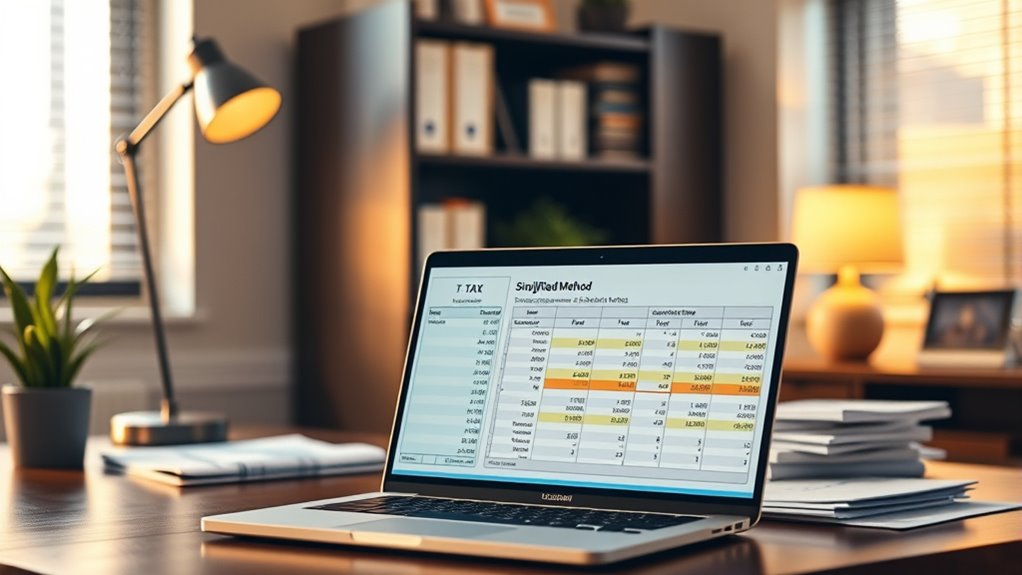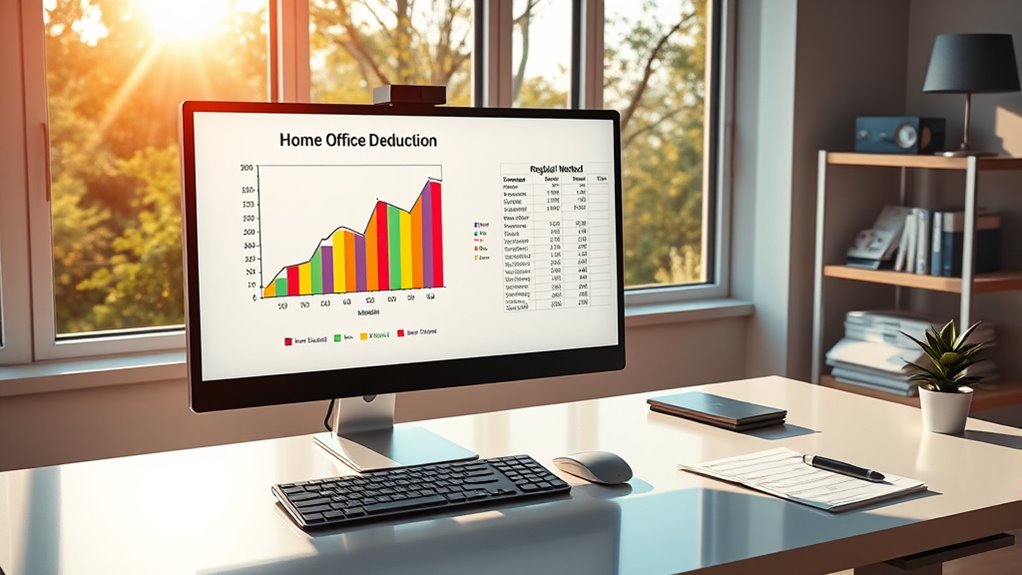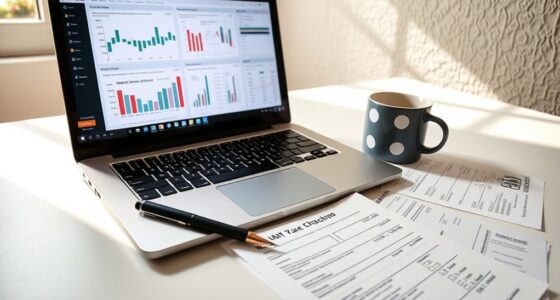In 2025, you can choose between the simplified and regular methods for your home office deduction. The simplified method offers a straightforward, flat $5 per square foot up to 300 sq ft, with minimal documentation. The regular method requires tracking actual expenses like rent, utilities, and repairs, and calculating the percentage used for work. Both methods have pros and cons—continue exploring to find out which suits your situation best.
Key Takeaways
- The simplified method offers a flat $5 per sq ft deduction, up to 300 sq ft, with minimal documentation.
- The regular method deducts actual expenses like mortgage interest, rent, and utilities, requiring detailed recordkeeping.
- Choosing the simplified method reduces calculation and documentation effort compared to the regular method.
- The regular method may provide higher deductions if home expenses are significant.
- Both methods require documentation to support the claimed deduction and ensure IRS compliance in 2025.

Are you wondering if you can claim a home office deduction on your taxes? If you work remotely or run a business from your home, understanding the deduction calculation and documentation requirements is essential. The IRS offers two methods to claim this deduction: the simplified method and the regular method. Each has its own advantages and considerations, so knowing how they work can help you maximize your benefits while staying compliant.
The simplified method is designed to make claiming your home office easier. It allows you to deduct a flat rate of $5 per square foot of your home used exclusively for business, up to a maximum of 300 square feet. This means you don’t need to calculate actual expenses like utilities, mortgage interest, or repairs, making the deduction calculation straightforward. However, even with this simplified approach, you still need to meet specific documentation requirements. You should keep records that establish the size of your home office, such as floor plans or photographs, and have proof that the space is used exclusively for work. While detailed expense tracking isn’t necessary for the simplified method, maintaining some form of documentation can be helpful in case of an audit.
On the other hand, the regular method involves calculating your actual expenses to determine your deduction. This includes a proportionate share of costs such as mortgage interest, property taxes, rent, utilities, repairs, and depreciation. To use this method, you need to keep detailed records of all expenses related to your home and how much of your home is dedicated to your business. Accurate recordkeeping is essential, as you’ll need to substantiate your deduction with receipts, invoices, and bank statements. The deduction calculation under this method can be more beneficial if your actual expenses are high, but it requires more meticulous documentation. You must also be prepared to allocate expenses appropriately based on the percentage of your home used for business purposes.
Frequently Asked Questions
Can I Switch Between Simplified and Regular Methods Annually?
Yes, you can switch between simplified and regular methods annually. Method switching is allowed as long as you maintain proper recordkeeping compliance when changing methods. Keep detailed records of your expenses and deductions to support your choice each year. Be aware that switching methods may require adjustments or reconciliation on your tax return, so plan accordingly and stay consistent with your documentation to avoid issues during audits or reviews.
What Are the Recordkeeping Requirements for Each Method?
Imagine your home office as a quiet sanctuary where your records tell the story. For the simplified method, keep basic records like square footage and dates, but detailed documentation isn’t required. With the regular method, however, you need thorough recordkeeping strategies, including receipts, invoices, and detailed expense logs to support your deductions. Accurate documentation requirements guarantee your home office claim remains a clear and well-organized part of your financial landscape.
How Does a Shared Workspace Affect My Deduction?
Sharing a workspace can decrease your deduction because you only claim the portion used exclusively for work. If you use a shared space, your deduction may be limited by the percentage of time or space dedicated solely to your business activities. Keep track of your actual costs and usage to guarantee you stay within deduction limits. This way, you accurately reflect your share of expenses without overstating your deduction.
Are There Specific Expenses Excluded From the Deduction?
You can’t deduct expenses for personal home items like home office furniture, as they’re considered personal expenses. However, utility expenses such as electricity, water, and internet are typically deductible if they’re used for your home office. Keep in mind, certain expenses like maintenance or repairs specific to your workspace are also deductible, but personal expenses outside your designated workspace are excluded. Always verify your deductions are directly related to your home office use.
Does the Method Impact State Tax Filings?
Your choice of filing method can impact your state tax implications. The simplified method often streamlines calculations and may be accepted by your state, but some states require the regular method for more precise deductions. You should review your state’s rules, as the method you choose for federal taxes might differ in its acceptance or calculation for state taxes. Always verify with state guidelines to ensure accurate filings.
Conclusion
Choosing between the simplified and regular methods is like selecting the right key for a door—each opens different possibilities. The simplified method offers ease, like a gentle breeze, while the regular method demands effort but unfastens deeper savings, like a sturdy lock. In 2025, your decision shapes your financial landscape, turning your home office into a symbol of both comfort and strategy. Trust your instinct; the right key will lead you through your fiscal journey.








